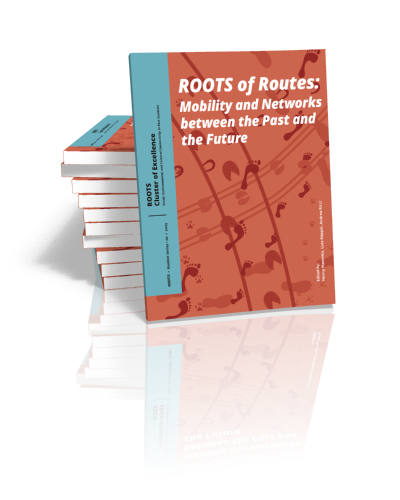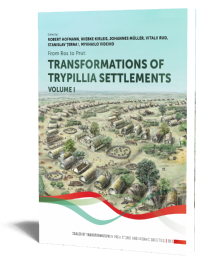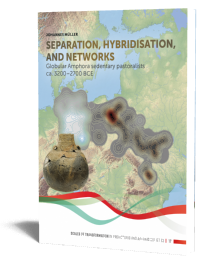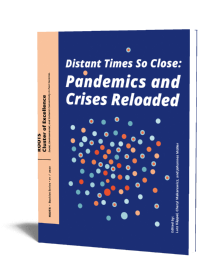Roots of Routes. Mobility and Networks between the Past and the Future
Edited by Henny Piezonka, Lutz Käppel & Andrea Ricci | 2023

Roots of Routes. Mobility and Networks between the Past and the Future
Edited by Henny Piezonka, Lutz Käppel & Andrea Ricci | 2023
Paperback ISBN: 9789464261912 | Imprint: Sidestone Press | Format: 170x210mm | 122 pp. | ROOTS Booklet Series • 02 / 2023 | Language: English | 10 illus. (bw) | 82 illus. (fc) | Keywords: archaeology; origins, routes; networks; mobility; trade; knowledge; prehistory; classical antiquity; migration | download cover | DOI: 10.59641/y1811bk
Read online or downloaded 1623 times
-
Digital & Online access
This is a full Open Access publication, click below to buy in print, browse, or download for free.
-
Buy via Sidestone (EU & UK)
-
Buy via our Distributors (WORLD)
For non-EU or UK destinations you can buy our books via our international distributors. Although prices may vary this will ensure speedy delivery and reduction in shipping costs or import tax. But you can also order with us directly via the module above.
UK international distributor
USA international distributor
-
Bookinfo
Paperback ISBN: 9789464261912 | Imprint: Sidestone Press | Format: 170x210mm | 122 pp. | ROOTS Booklet Series • 02 / 2023 | Language: English | 10 illus. (bw) | 82 illus. (fc) | Keywords: archaeology; origins, routes; networks; mobility; trade; knowledge; prehistory; classical antiquity; migration | download cover | DOI: 10.59641/y1811bk
Read online or downloaded 1623 times

We will plant a tree for each order containing a paperback or hardback book via OneTreePlanted.org.
People and spaces have always been connected by routes: paths, trails, roads – on land, on water and sometimes even through the air, over hill and dale as well as over wooden planks, pavement and asphalt. Humans and animals followed them. The routes directed the circulation of raw materials and goods. They determined the paths on which humans fled from misery and danger, and they constituted the physical and imagined veins of networks between communities. All these cultural and biological connectivities are the building blocks of reshaping past (and present) societies.
In this booklet – the second in the booklet series of the Cluster of Excellence ROOTS at Kiel University – we uncover the roots of these routes: From the earliest stages of the Stone Age to the present day, there have been well-defined routes, which enabled the exchange of things, practices and knowledge between people. Many of these ancient routes are not only still visible today, but even continue to operate: from the Silk Roads spanning the continents to the local routes of the Ox Trail in Schleswig-Holstein, from the waterways of Mesopotamia and the river worlds of the forest zone to the spiritual routes of philosophical contemplation. Moreover, isolation and disruptions of formerly established routes, for example in the Viking diaspora, have also proven to be directional for cultural developments. In a kaleidoscope of perspectives, the roles of landscape and climate are examined. Special attention is given to those routes along which objects, rituals, and therefore also cultural practices were transported. Religious rituals, knowledge, even philosophical insights are shown to have their roots in movement along routes.
These and the many other topics in this booklet illustrate to what extent the development of human societies is determined by the routes through which they are connected – or not connected. Modern narratives of a limitless, openly accessible world, grounded in an urban-industrialised experience (or agenda), can get cracks if we look deep enough into the past. It is the paths, the very concrete connections in a material as well as a spiritual sense that influence human lives, their existence and their development. Communication and dialogue along the routes and networks must be maintained, as they were and are the guarantors for a good coexistence of humans in this world.
Preface: Perspectives on Past Routes, Networks and Society in Challenging Times
Johannes Müller
Chapter 1: The ROOTS of Routes – Framing Connections in (Pre-)History
Introduction: A Deep History of Routes Connecting People, Places, and Ideas
Henny Piezonka, Lutz Käppel, Andrea Ricci
Globalisation? What Globalisation?
Tim Kerig
Chapter 2: How to Choose a Route?
Routes in the Landscape – Ecological and Social Conditions for the Exchange of Goods, Ideas and People in the Past
Walter Dörfler
Entangled Mobilities – The Interconnection of Human Routes and Animal Movement
Henny Piezonka and Karolina Varkuleviciute
Climate Refugees
Mara Weinelt
Chapter 3: How Far Back Do Our Routes Go?
Sunken Pathways in the North Sea – Tracking Late Palaeolithic Reindeer Hunters off the Coast of Heligoland
Berit Valentin Eriksen and Wolfgang Rabbel
Rooting the Silk Road
Johanna Hilpert and Jutta Kneisel
On the Road Again: Travelling through Jutland – The Ox Trail, a Millennia-old Road
Jutta Kneisel, Bente Majchczack, Franziska Engelbogen, Anna K. Loy, Oliver Nakoinz
Walking on Ancient Paths – Are We Still Using Celtic Trails?
Franziska Engelbogen
Connection Breakdown – Three Vikings Abroad
Jens Schneeweiß and Henny Piezonka
Chapter 4: Routes of Things and Technologies
Cattle and Wagons – The First “Wild West” in Europe? The Wheel Innovation in the Baltic-Pontic Region 3500-2500 BCE
Johannes Müller
Trackways across the Bog
Jan-Piet Brozio
The Road to Riches – Amber Routes in Bronze Age Europe
Benjamin Serbe and Khurram Saleem
Analysing Amber
Khurram Saleem and Benjamin Serbe
The Power of Water – Water Connectivities in Mesopotamia
Andrea Ricci
How Did Buddha Come to Sweden?
Jens Schneeweiß
Chapter 5: Routes of Rituals and Knowledge
At the End of the Road – What Graves Tell Us about Networks and Contacts in Prehistory
Fynn Wilkes and Henry Skorna
Mermaids, Faces, Houses and Birds – Symbols of Connectivity
Jutta Kneisel
Theoria – The Pilgrimage to the Sanctuary as a Journey to Knowledge or What the Modern Concept of “Theory” Has to Do with a Religious Practice in Ancient Greece
Lutz Käppel
Pathways between the Worlds – The Sacred Ecology of River Routes
Henny Piezonka
Chapter 6: Conclusion
Along the Way – A Look Back Ahead
Lutz Käppel, Henny Piezonka, Andrea Ricci
Map of the Topics
Contributors
For further reading
Imprint

Prof. dr. Lutz Käppel
Studies of Classics in Tübingen and Oxford, PhD 1990, Habilitation 1997, Professor of Classics, especially Greek Literature at the Christian-Albrechts-Universität zu Kiel 1999-, Ordinary Member of the German Archaeological Institute 2000-, Dean of the Faculty of Humanities 2006-2008, Co-Coordinator of the Kiel Graduate School ‘Human Development in Landscapes’ 2007-2016; Speaker of the University’s Research Focus ‘Social, Environmental, Cultural Change’ 2007–.

Dr. Andrea Ricci
Andrea Ricci is an archaeologist specialised in the study of the prehistory of Southwestern Asia. He completed his first MA studies at La Sapienza University in Rome (Italy) and then he received a second MA degree at Durham University (UK). After completing his PhD in the framework of the Graduate School “Human Development in Landscapes” at Kiel University, he held a post-doctoral position at the Eurasia Department of the German Archaeological Institute. He is currently a scientific coordinator of the Cluster of Excellence ROOTS at Kiel University. He has conducted field projects in Azerbaijan, Georgia, and Syria.
Dr. Henny Piezonka
Henny Piezonka (PhD, Free University Berlin, 2010) has been a Junior Professor for Anthropological Archaeology at Kiel University, Germany, since 2016. In May 2023, she was appointed University Professor for Prehistoric Archaeology at the Free University Berlin, Germany.
Abstract:
People and spaces have always been connected by routes: paths, trails, roads – on land, on water and sometimes even through the air, over hill and dale as well as over wooden planks, pavement and asphalt. Humans and animals followed them. The routes directed the circulation of raw materials and goods. They determined the paths on which humans fled from misery and danger, and they constituted the physical and imagined veins of networks between communities. All these cultural and biological connectivities are the building blocks of reshaping past (and present) societies.
In this booklet – the second in the booklet series of the Cluster of Excellence ROOTS at Kiel University – we uncover the roots of these routes: From the earliest stages of the Stone Age to the present day, there have been well-defined routes, which enabled the exchange of things, practices and knowledge between people. Many of these ancient routes are not only still visible today, but even continue to operate: from the Silk Roads spanning the continents to the local routes of the Ox Trail in Schleswig-Holstein, from the waterways of Mesopotamia and the river worlds of the forest zone to the spiritual routes of philosophical contemplation. Moreover, isolation and disruptions of formerly established routes, for example in the Viking diaspora, have also proven to be directional for cultural developments. In a kaleidoscope of perspectives, the roles of landscape and climate are examined. Special attention is given to those routes along which objects, rituals, and therefore also cultural practices were transported. Religious rituals, knowledge, even philosophical insights are shown to have their roots in movement along routes.
These and the many other topics in this booklet illustrate to what extent the development of human societies is determined by the routes through which they are connected – or not connected. Modern narratives of a limitless, openly accessible world, grounded in an urban-industrialised experience (or agenda), can get cracks if we look deep enough into the past. It is the paths, the very concrete connections in a material as well as a spiritual sense that influence human lives, their existence and their development. Communication and dialogue along the routes and networks must be maintained, as they were and are the guarantors for a good coexistence of humans in this world.
Also available in German here.
Contents
Preface: Perspectives on Past Routes, Networks and Society in Challenging Times
Johannes Müller
Chapter 1: The ROOTS of Routes – Framing Connections in (Pre-)History
Introduction: A Deep History of Routes Connecting People, Places, and Ideas
Henny Piezonka, Lutz Käppel, Andrea Ricci
Globalisation? What Globalisation?
Tim Kerig
Chapter 2: How to Choose a Route?
Routes in the Landscape – Ecological and Social Conditions for the Exchange of Goods, Ideas and People in the Past
Walter Dörfler
Entangled Mobilities – The Interconnection of Human Routes and Animal Movement
Henny Piezonka and Karolina Varkuleviciute
Climate Refugees
Mara Weinelt
Chapter 3: How Far Back Do Our Routes Go?
Sunken Pathways in the North Sea – Tracking Late Palaeolithic Reindeer Hunters off the Coast of Heligoland
Berit Valentin Eriksen and Wolfgang Rabbel
Rooting the Silk Road
Johanna Hilpert and Jutta Kneisel
On the Road Again: Travelling through Jutland – The Ox Trail, a Millennia-old Road
Jutta Kneisel, Bente Majchczack, Franziska Engelbogen, Anna K. Loy, Oliver Nakoinz
Walking on Ancient Paths – Are We Still Using Celtic Trails?
Franziska Engelbogen
Connection Breakdown – Three Vikings Abroad
Jens Schneeweiß and Henny Piezonka
Chapter 4: Routes of Things and Technologies
Cattle and Wagons – The First “Wild West” in Europe? The Wheel Innovation in the Baltic-Pontic Region 3500-2500 BCE
Johannes Müller
Trackways across the Bog
Jan-Piet Brozio
The Road to Riches – Amber Routes in Bronze Age Europe
Benjamin Serbe and Khurram Saleem
Analysing Amber
Khurram Saleem and Benjamin Serbe
The Power of Water – Water Connectivities in Mesopotamia
Andrea Ricci
How Did Buddha Come to Sweden?
Jens Schneeweiß
Chapter 5: Routes of Rituals and Knowledge
At the End of the Road – What Graves Tell Us about Networks and Contacts in Prehistory
Fynn Wilkes and Henry Skorna
Mermaids, Faces, Houses and Birds – Symbols of Connectivity
Jutta Kneisel
Theoria – The Pilgrimage to the Sanctuary as a Journey to Knowledge or What the Modern Concept of “Theory” Has to Do with a Religious Practice in Ancient Greece
Lutz Käppel
Pathways between the Worlds – The Sacred Ecology of River Routes
Henny Piezonka
Chapter 6: Conclusion
Along the Way – A Look Back Ahead
Lutz Käppel, Henny Piezonka, Andrea Ricci
Map of the Topics
Contributors
For further reading
Imprint

Prof. dr. Lutz Käppel
Studies of Classics in Tübingen and Oxford, PhD 1990, Habilitation 1997, Professor of Classics, especially Greek Literature at the Christian-Albrechts-Universität zu Kiel 1999-, Ordinary Member of the German Archaeological Institute 2000-, Dean of the Faculty of Humanities 2006-2008, Co-Coordinator of the Kiel Graduate School ‘Human Development in Landscapes’ 2007-2016; Speaker of the University’s Research Focus ‘Social, Environmental, Cultural Change’ 2007–.

Dr. Andrea Ricci
Andrea Ricci is an archaeologist specialised in the study of the prehistory of Southwestern Asia. He completed his first MA studies at La Sapienza University in Rome (Italy) and then he received a second MA degree at Durham University (UK). After completing his PhD in the framework of the Graduate School “Human Development in Landscapes” at Kiel University, he held a post-doctoral position at the Eurasia Department of the German Archaeological Institute. He is currently a scientific coordinator of the Cluster of Excellence ROOTS at Kiel University. He has conducted field projects in Azerbaijan, Georgia, and Syria.
Dr. Henny Piezonka
Henny Piezonka (PhD, Free University Berlin, 2010) has been a Junior Professor for Anthropological Archaeology at Kiel University, Germany, since 2016. In May 2023, she was appointed University Professor for Prehistoric Archaeology at the Free University Berlin, Germany.
-
Digital & Online access
This is a full Open Access publication, click below to buy in print, browse, or download for free.
-
Buy via Sidestone (EU & UK)
-
Buy via our Distributors (WORLD)
For non-EU or UK destinations you can buy our books via our international distributors. Although prices may vary this will ensure speedy delivery and reduction in shipping costs or import tax. But you can also order with us directly via the module above.
UK international distributor
USA international distributor
- Browse all books by subject
-
Search all books

We will plant a tree for each order containing a paperback or hardback book via OneTreePlanted.org.
You might also like:
© 2026 Sidestone Press KvK nr. 28114891 Privacy policy Sidestone Newsletter Terms and Conditions (Dutch)








